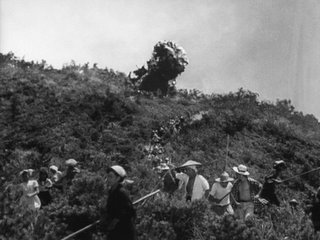Godzilla (Gojira, 1954)
Director: Ishirô Honda
A newly restored print of the Japanese version of this staple of the monster movie genre made the art house rounds in 2004 and was released on
 DVD to honor the 50th anniversary of the film's theatrical debut. This film is a substantial 98 minutes in length and has lost the bad dubbing, distorted storyline, and Raymond Burr character found in the film many of us saw in our youth. In the process, the film is made almost unrecognizable to the memory and a much richer experience to the mature movie buff who wants more than cheesy thrills.
DVD to honor the 50th anniversary of the film's theatrical debut. This film is a substantial 98 minutes in length and has lost the bad dubbing, distorted storyline, and Raymond Burr character found in the film many of us saw in our youth. In the process, the film is made almost unrecognizable to the memory and a much richer experience to the mature movie buff who wants more than cheesy thrills. The truncated American version of the film started after the destruction of Tokyo by Godzilla. The original film builds slowly. A fishing boat, then another, then a veritable fleet are burned and swallowed by the ocean off Odo Island. A handful of survivors from these mysterious disasters report that the ocean seemed to explode. Reconnaissance missions and scientific expeditions come up empty. Then an attack occurs on Odo itself. An old island man says it is Godzilla, a creature of the ocean that periodically comes to feast on humans when fish are not in abundant supply.
A paleontologist, played by renowned Japanese actor Takashi Shimura (the lead in Ikiru and other Kurosawa masterpieces), heads a small party to Odo Island where they find footprints
 that are radioactive. Then Godzilla’s head appears above the peak of a mountain. The paleontologist recognizes it as a dinosaur from the Jurassic period and theorizes that the monster is radioactive because it was able to withstand the effects of the H-bombs tested in its underwater habitat.
that are radioactive. Then Godzilla’s head appears above the peak of a mountain. The paleontologist recognizes it as a dinosaur from the Jurassic period and theorizes that the monster is radioactive because it was able to withstand the effects of the H-bombs tested in its underwater habitat. The film casts a jaundiced eye at science throughout. Shimura’s character advocates study, not murder, of the beast, even after Godzilla has wrecked some preliminary destruction on the outskirts of Tokyo. The scientist who possesses the means of Godzilla’s destruction initially refuses to reveal it, fearing that it will be used by politicians for destructive purposes in the future. He is the Robert Oppenheimer of Japan. Godzilla itself is a product of H-bombs and has become an instrument of destruction that no longer seems content to prey on a few humans in times of need. The beast’s out-of-control rage seems to represent the destructive power of nature unnaturally tampered with, and humanity grown too prideful.
Numerous references to H-bombs are made, and the real fire bombing of Tokyo is painfully evoked in Godzilla’s rampage. Victims are taken to a hospital, where they are tested with a Geiger counter; some are found to have absorbed lethal levels of radiation. The sickness and death that visited Japan for years after the H-bomb attacks are economically evoked in this short hospital scene. From what I have read, the film’s director, Ishiro Honda, served in the Imperial army, whereby he witnessed the fire bombing and passed through the ruins of Hiroshima. These experiences lend to the authenticity of the events depicted, even as Godzilla and the Tokyo it wrecks are obviously fake.
Godzilla eventually is stopped. Shimura says that there must be other creatures like Godzilla, if this one survived. I chuckled a bit at the obvious sequel set-up, but my laughs were silenced by Shirmura’s fears of what further horrors might await them because of humanity’s tampering with the forces of nature. It showed how sobered Japanese aggression was by annihilation. This film is unusually sad and very Japanese in its reverence for nature and belief in myth. This is a new Godzilla ripe for a new, more mature audience. l
To view a stills storyboard of Godzilla, go to http://www.tokyomonsters.com/images-stills-g54-page1.php
For everything in Japanese movie monsters, go to http://www.tokyomonsters.com


0 Comments:
Post a Comment
<< Home